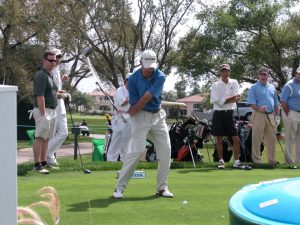“Strict Rules of Golf, Mr. Bond?”

by Dr. T. J. Tomasi Keiser University College of Golf Senior Faculty and Director of Research
Remember the arch-villain, Goldfinger, who baited 007 before their epic match – “Strict rules of golf, Mr. Bond?” But of course, he was not about to play by the strict rules, and neither, as it turned out, was James Bond. And these two are certainly not the only ones who play by their own rules — a lot of golfers do.
There are generally three types of golfers when it comes to the rules:
1. Those golfers that follow the strict rules of golf – right from the book
2. A second group that follows their own rules of golf
3. A third group that follows no rules of golf.
The most common group is #2, but under special circumstances, respected pros bend the rules. Golf pros or tournament quality amateurs playing a practice round or just for fun often will take a mulligan. And there are very specific circumstances where a pro bends the rules. Perhaps the most celebrated case involved long-time USGA board member Arnold Palmer, one of golfs most respected legends, endorsing the use of a non-conforming driver [the ERC II] by Callaway, shortly after signing a lucrative contract with Callaway. Palmer revealed that he used the driver in his matches with the boys at Bayhill, his home course, even though it was against the “strict rules of golf.”
The second group is by far the largest of the three and is made up of amateurs who have their own rules. One way to think about these shadow rules is that since golfers have always done it, shadows are an integral part of the tradition of golf. Here are some of the rules that are de facto different at the tournament level vs. normal amateur play: 14 club limit is exceeded; preferred lies – nudge it to a better lie; mulligans or do-overs; no stroke and distance penalty on an OB; all water hazards are played as laterals; drop it anywhere for relief; hit when ready; — and a host of other procedures, often related to gambling that makes the debate largely academic since there are so many ‘shadow rules’ already embedded in the fabric of the game.
The third group often referred to as ‘family golf,’ has just one rule: Have fun and hit it until you get tired (which is two rules, but who’s counting).
The Takeaway:
There are a few circumstances where you must follow the strict ‘rules of golf’ unless otherwise stated by the tournament committee:
1. Tournament golf
2. Posting scores for handicap, or
3. A money match where any deviations from the strict rules are agreed to.
If you don’t follow the rules under these circumstances, you’re either ignorant, a cheater, or both.
Note: There can be a difference between a cheater and someone who doesn’t play by the rules. A cheater knows the rules but breaks them when it’s helpful. A player may break a rule but not realize it, a situation that softens the impact of the infraction but can still ruin a reputation.
The safest way to prevent problems is to outline on the first tee, before the game begins, what special rules you’re playing by – if any. For example, when I’m playing a relaxed round, especially if it’s crowded, I suggest we play all out-of-bounds as a lateral hazard. I do this for two reasons: 1) It saves time, and 2) it’s dangerous walking back to the spot you hit it from. I’m not cheating, just being practical.

A tour pro tees off while his team watches. You can tell he’s a pro by the late release, i.e., the huge angle between his lead arm and the shaft when the hands are about waist high. In the pro-ams, the pro hits from the back tees while the amateurs get to move forward – this is a special rule on the rule sheet published by the PGA Tournament committee. The amateurs get to wear shorts if they want, but the male pros must wear long pants.
If you’d like to study with Dr. Tomasi and other PGA Master Professionals, contact The College of Golf today.














